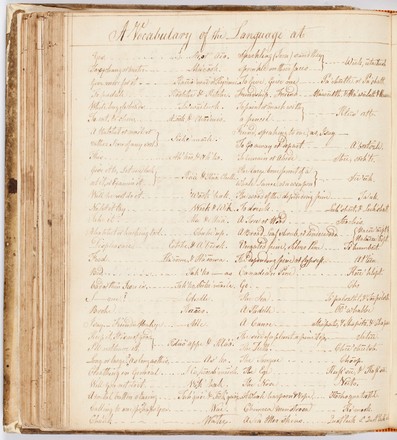A vocabulary of the language at King Georges Sound
from the log and journal of HMS Resolution, 1778
Manuscript
Bequest of Sir William Dixson, 1952
DLMS 98
Cook’s third and final voyage was an attempt to locate the North-West Passage, an ice-free sea route which linked the Atlantic to the Pacific. After a year among the islands of the South Pacific, the expedition sailed north to explore the northwest coast of America to the Arctic Circle. On this part of the voyage, he spent a month in Nootka Sound, also called King George’s Sound, in what is now the Canadian province of British Columbia. While there, he traded with the indigenous Nuu-chah-nulth people, and it is their language which King records in this journal.
James King served as second lieutenant on this voyage. The journal entries pre-date Cook’s death in Hawaii in 1779.
Cook
is widely acknowledged as a great seaman, explorer, surveyor and mapmaker. He
is also remembered for the strict attention he paid to the health and diet of
his crew, which eliminated scurvy, the
scourge of long-distance sea voyages.
King Georges Sound, also known as Nootka Sound, is an inlet that separates Vancouver Island and Nootka Island in British Columbia. James Cook’s third voyage visited there in March 1778, remaining for four weeks.
During
this expedition, James King shared the duties of astronomer with Cook, taking
astronomical observations to establish the Resolution's position at sea
and on shore to establish the geographical position of salient points during
the course of Cook's surveys. King's observations were an important
contribution to the accuracy of the various surveys carried out during the
voyage.
Among the officers on Cook’s
third voyage were George Vancouver, who would later lead a four-year survey of
the northwest coast of America, and William Bligh, who would become famous as
the fourth governor of NSW and as a result of the mutiny on his ship the Bounty.
At the time of Cook’s
discovery of Nootka Sound (also known as King George’s Sound) there was an
established village inside the entrance to the north in what is still known as
Friendly Cove. English and American fur traders later used the sound as a
trading station and as a place of shelter and secure anchorage.



 Back to list
Back to list